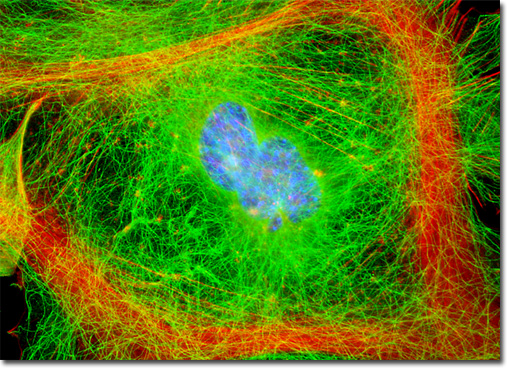Fluorescence Digital Image Gallery
Embryonic Swiss Mouse Fibroblast Cells (3T3)
|
Fibroblasts are the principal cells of connective tissue. Distributed widely throughout the body, connective tissue exhibits a relatively few number of cells and a relatively large amount of intercellular substance. The cells of the tissue consist of macrophages, adipose cells, mast cells, lymphocytes, monocytes, eosinophils, and plasma cells, in addition to fibroblasts. The matrix secreted by the cells is comprised of the amorphous, hydrated material known as ground substance and fibers. Among the chief functions of connective tissue are imparting structural support and assisting in the protection of the body, as well as providing a site for fat storage. Alexa Fluor 568 conjugated to phalloidin, which targets cytoskeletal filamentous actin, and DAPI, which binds to DNA in cell nuclei, were used to probe a culture of Swiss mouse embryo fibroblast cells (illustrated above). In addition, the 3T3 cells were immunofluorescently labeled with primary anti-tubulin mouse monoclonal antibodies followed by goat anti-mouse Fab fragments conjugated to Cy2, targeting the microtubule network. Images were recorded in grayscale with a QImaging Retiga Fast-EXi camera system coupled to an Olympus BX-51 microscope equipped with bandpass emission fluorescence filter optical blocks provided by Omega Optical. During the processing stage, individual image channels were pseudocolored with RGB values corresponding to each of the fluorophore emission spectral profiles. |
© 1995-2025 by Michael W. Davidson and The Florida State University. All Rights Reserved. No images, graphics, software, scripts, or applets may be reproduced or used in any manner without permission from the copyright holders. Use of this website means you agree to all of the Legal Terms and Conditions set forth by the owners.
This website is maintained by our
|
